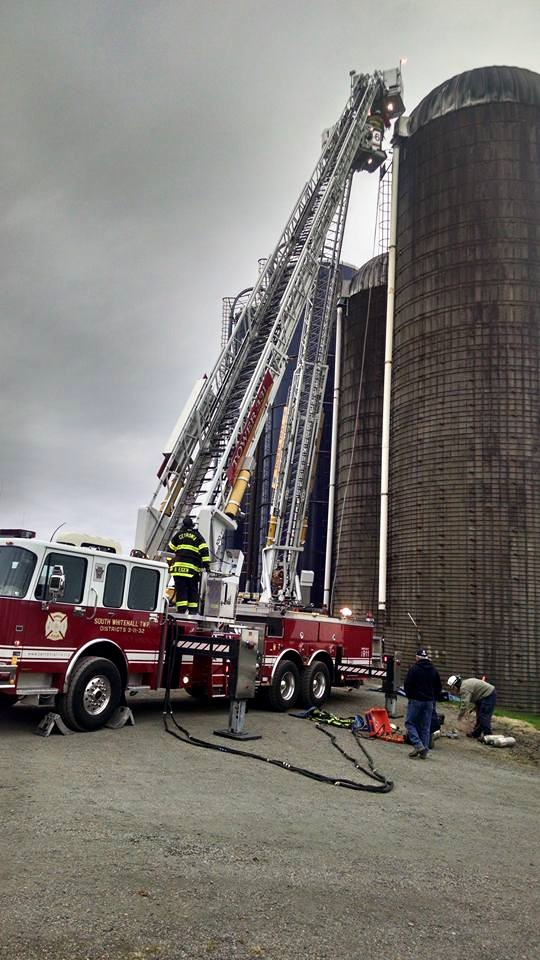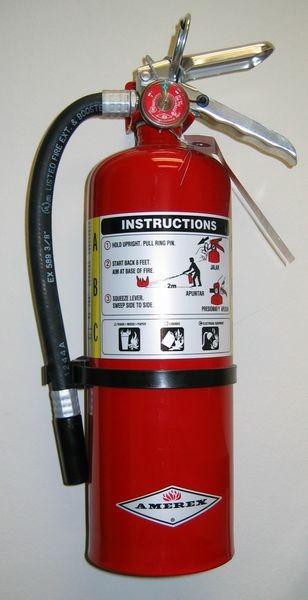
Use the following format to cite this article: Silo fire prevention and management. (2015) Farm and Ranch eXtension in Safety and Health (FReSH) Community of Practice. Retrieved from http://articles.extension.org/pages/70637/silo-fire-prevention-and-manag….
Because the ingredients needed for a fire to occur are present in silos, agricultural producers who have silos should take steps to minimize the likelihood of silo fires and be prepared to manage silo fires should they occur. Fire prevention steps are similar regardless of what type of silo you have. The approach to managing a fire, however, is based on the type of silo in which the fire is burning.
Ingredients for Fire
Three ingredients are needed for anything to burn: a heat source, air, and fuel.
- The heat source for a silo fire is bacterial action within the silage. When forage material is cut, bacterial action on the forage begins. This action produces heat until all the oxygen in the pile is consumed. Microorganisms are killed at 250°F–400°F, causing a breakdown in the forage through an oxidation process called pyrolysis. Pyrolysis allows oxygen in the silo to support a smoldering fire that can result in charred cavities in the silage. Once the oxygen is consumed, the fermentation process begins and continues until the forage becomes stable.
- The air source for a silo fire includes air that is trapped in chopped forage during harvest and air that blows into the silo. The dryer the material, the more trapped air there is.
- The fuel source for a silo fire is the silage, although it typically is not a highly effective fuel source because of its moisture content. Even dry silage is too wet to burn quickly.
Causes of Silo Fires
The three main types of upright silos found on farm operations are conventional, oxygen-limiting, and modified oxygen-limiting. Typically, silo fires occur more frequently in conventional silos than in oxygen-limiting silos because oxygen is present in greater amounts in conventional silos. Many silo fires occur in the top layer (approximately the top 10 feet) of dry, loosely packed silage. Such fires can be the result of an overheating unloader motor but more often are caused by spontaneous combustion. Spontaneous combustion can occur when new silage having a too-low moisture content (less than 45%) is placed in the silo, when fresh silage is placed on top of old silage, or when the silo has poorly maintained doors and walls. Putting new silage on top of old silage is especially risky if the old silage is too dry. The dryer the material is, the more air that will be trapped when fresh, wetter material is placed on top of it. That trapped air can allow excessive heating and support a smoldering fire.
A silo fire can start from a source outside the silo as well. The two most common examples of these types of fires are a fire in the chute from a shorted-out electrical wire or a fire from an adjacent barn fire.
Prevention of Silo Fires
Prevention of silo fires involves performing proper maintenance on silos and unloaders and taking appropriate steps when harvesting and storing forages.
Silo and Unloader Maintenance
When a silo is empty, inspect the silo walls (especially the lower 10–15 inches), the silo doors, and the unloader system. Make any necessary repairs. If you have an oxygen-limiting silo, pressure-test it on a regular basis (at least once every other year, preferably when empty). If air is allowed to leak into an oxygen-limiting silo, forage quality can decline, and the chance of a fire developing increases. Many fires have started in oxygen-limiting silos that have been unused for several years but not emptied.
For the unloader system, examine belts, bearings, wiring, and the motor. Lubricate the lift cables, and immediately replace any lift cable showing signs of kinks, cuts, or corrosion. Check for damaged insulation or terminals on the unloader power cable, and repair or replace damaged materials as needed.
Harvesting and Storage Recommendations
Implementing the following steps for harvesting and storing forages will decrease the risk of a silo fire occurring:
- Minimize drying time to reduce respiration.
- Chop forage at the correct theoretical length cut (TLC). The TLC for hay crop silage is 3/8 inch; the TLC for corn silage is 1/4 inch. Follow the silo manufacturer’s recommendations.
- Ensile at 30%–50% dry matter content (i.e., 50%–70% moisture content), based on the silo manufacturer’s recommendations. Using this approach will optimize fermentation.
- Leave the silo sealed for at least 14 days to allow complete fermentation to occur.
- Unload 2–6 inches per day, and maintain a smooth surface. Using this unloading schedule will help you stay ahead of any spoilage. Spoilage is caused by the bacterial action that can cause heating.
- Discard deteriorated silage. Performing this step will help eliminate a fuel source for potential fires and minimize animal health problems.
Management of Silo Fires
Managing silo fires involves monitoring silage to detect a fire early, taking the proper steps when you suspect or discover that a fire is burning, and understanding how fires in different types of silos are extinguished.
Monitoring of Silage
Silage is costly to replace, so one of the main goals of managing a silo fire is to locate the fire and control the area so that only a minimum amount of silage is affected. The first step in managing a silo fire is early detection, so monitor a silo for three weeks postharvest. This length of time is the critical period for fermentation and heating to occur. Because silage burns slowly, detecting a fire early allows you time to evaluate your options and develop a plan for addressing the fire.
Response to the Presence of a Fire
If you suspect or discover a silo fire, contact your local fire department immediately. A silo is a confined space, and firefighters are obligated to follow the US Department of Labor, Occupational Safety and Health Administration (OSHA) Confined Space Standard for entry into a silo. When you contact the fire department, indicate the type of fire so that the fire department can dispatch the correct personnel and equipment (e.g., thermal imaging camera, infrared heat gun, self-contained breathing apparatus).
Wait for the fire service personnel to arrive. Do not enter the silo or climb the chute because unknown factors, such as fire gases or burning embers falling down the chute, may exist. Only rescue personnel with self-contained breathing apparatuses or supplied-air respirators should enter an upright silo because of toxic gases that can be present due to the fermentation process or the fire. The most typical gases in silos include carbon monoxide, carbon dioxide, nitric oxide, nitrogen dioxide, and nitrogen tetroxide. Additional gases can be present due to the burning of substances such as silo liners and epoxy coatings.
While waiting for fire service personnel to arrive on the scene, take the following steps:
- Close the bottom of the chute to reduce airflow that may be fanning the fire. Use sheet metal or another noncombustible material to close the chute.
- Remove all livestock from any exposed or adjacent buildings.
- Spray water to wet down the area around the silo chute to prevent the fire from spreading.
- Place noncombustible shields (metal siding, etc.) over any openings in the silo or chute to prevent sparks and embers from flying into or onto other buildings.
Fire Management Approaches for Various Silo Types
It is important to understand how silo fires are managed in various silo types. A fire in a conventional silo will not burn out; instead, it must be extinguished. A fire in oxygen-limiting silo may be managed so that it burns out, or it may have to be extinguished. To extinguish a silo fire, it is necessary to eliminate one of the ingredients needed for fire to occur. Trained fire service personnel are needed to extinguish a fire in any type of silo.
Conventional Silo
Because a conventional silo is not airtight, fire service personnel cannot smother the fire by eliminating the air source. The best approach is to locate the heat source and remove it. If possible, fire service personnel should avoid flooding the silo with water for the following reasons: doing so could ruin good feed; it is difficult to unload wet silage with an unloader; water can damage the silo; and the introduction of water can actually cause additional fires in the silo.
Oxygen-Limiting Silo
With proper management, you may be able to allow a fire in an oxygen-limiting silo to burn out. To reduce any additional air from entering the silo, close the top hatch cover (without latching it) and the bottom unloading door. CAUTION If the silo is heavily smoking or rumbling (vibrating), do not attempt to close the top hatch; rather stay off the silo! The assumption is that after you close the top hatch cover and bottom unloading door, no air will go into the silo, so the fire eventually will use up the residual air in the silo and burn out over time. However, this process can take up to three weeks. If this approach does not work, trained personnel—usually representatives of the silo manufacturer/dealer—can inject carbon dioxide or liquid nitrogen into the silo, causing any oxygen trapped by the silage to be consumed and allowing the fire to burn out.
A concern related to a fire in an oxygen-limiting silo is the potential buildup of confined gases within the silo. Through pyrolysis, a smoldering fire will produce large quantities of carbon monoxide and other products that can result in an explosion when combined with air from outside the silo. Consequently, you should do nothing that will cause air to go into the silo. For example, do not add water or foam or open any portals into the silo.
Modified Oxygen-Limiting Silo
For fire management purposes, you can treat an oxygen-limiting silo that has been modified through the installation of a top unloader the same way as a nonmodified oxygen-limiting silo, at least initially. However, in spite of such modification, these structures are still airtight enough to allow for a dangerous buildup of carbon monoxide in a smoldering fire. In more than one case, an explosion has occurred during firefighting operations involving a modified oxygen-limiting silo.
Additional Recommendations
- Specialized training in proper techniques for responding to silo fires is available for fire department personnel. If your local firefighters have not had such training, encourage them to locate and participate in a training program.
- If you no longer use a silo, make sure that it is completely empty. Residual silo material can dry out and pose a fire risk.
- In the event of a silo fire, do not apply cool or cold water to the outside of a silo because doing so may cause structural damage.
- After a silo fire, inspect the silo, and make any necessary repairs.
Resources
Click here for a guide to assisting firefighters at the scene of a silo fire.
Sources
Florida Forage Handbook. (2008). University of Florida Institute of Food and Agricultural Sciences (IFAS). Retrieved from http://edis.ifas.ufl.edu/pdffiles/ag/ag36200.pdf.
Hill, D. (2009) Silo fires—protect your investment. Pennsylvania State University. Retrieved from http://www.farmemergencies.psu.edu/SiloFires-ProtectYourInvestment2.pdf.
Murphy, D., and Arble, W. (2000) Extinguishing fires in silos and hay mows. New York: Natural Resource, Agriculture, and Engineering Service.

